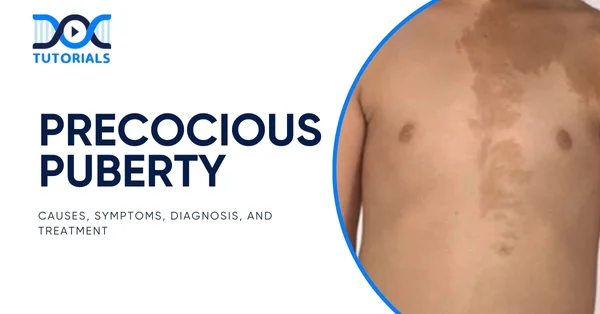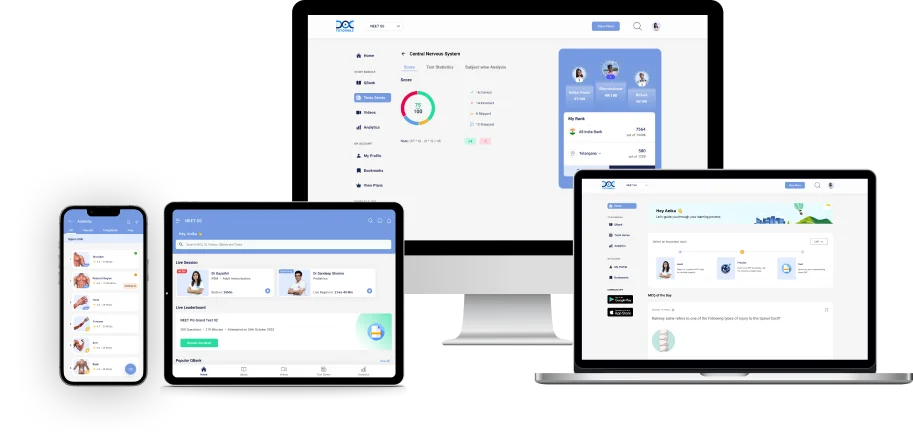Precocious Puberty: Causes, Symptoms, Diagnosis, and Treatment

In a cross-sectional study carried out on precocious puberty among 500 school-going girls (age 10-15 years) in 2017 in Kollam, Kerala, the prevalence rate was 10.4%, with urban being 12.35% and rural 8.43%. The worldwide rates are significantly lower, around 1 in 4,000 (0.025%) children. This dramatic inconsistency points to local nutritional and environmental factors as well as to the necessity of greater epidemiological data among Indians.
Precocious puberty is a growing concern in a developing country like India. So, if you are preparing for the NEET PG examination, then you should know about precocious puberty, its causes, symptoms, diagnosis, and treatment.
Read on to know more about precocious puberty!
What is Precocious Puberty?
Precocious puberty is classified as an earlier-than-normal development of secondary sexual characteristics in girls under 8 years old and boys under 9 years old. It is further divided into central (GnRH-dependent) and peripheral (GnRH-independent) types.
Premature stimulation of the hypothalamic-pituitary-gonadal axis accelerates the maturation of the bone and early epiphyseal closure, which means a shortened adult height. Psychologically, the girls may experience low self-esteem, augmented peer pressure, and risk‑taking behaviours, such as drugs and alcohol.
What are the Causes of Precocious Puberty?
To be able to explain the reason why some children develop precocious puberty, it is important to learn about the normal way puberty starts. The process is triggered in the brain through the secretion of gonadotropin-releasing hormone (GnRH). This hormone triggers the pituitary gland, which is a tiny, nondescript gland at the bottom of the brain, to release the luteinising hormone (LH) and the follicle-stimulating hormone (FSH).
These, in turn, trigger production of oestrogen in girls and testosterone in boys through the ovaries and testes, respectively. These sex hormones cause the occurrence of the secondary sexual characteristics.
The precocious puberty causes depend on its type. This condition is broadly categorised into two types based on the underlying mechanism:
- Central Precocious Puberty (CPP)
This is the more prevalent one, and it is GnRH-dependent. Puberty starts too early, but follows the normal development path. In the majority of cases, particularly in girls, no definable cause is established.
Rare causes include:
- Tumours of the hypothalamus or the pituitary
- Congenital brain malformations, i.e., hydrocephalus or hypothalamic hamartomas
- Genetic defects
- Exposure to radiation
- Trauma or injury to the CNS (Central Nervous System)
- Peripheral Precocious Puberty (PPP)
It is also known as GnRH-independent precocious puberty. In this condition, the sex hormones (oestrogen or testosterone) are generated without the activation of the hypothalamic-pituitary-gonadal (HPG) axis. The reason is connected to the fact that sex hormones are directly produced by different organs.
Potential causes include:
- Hormone-secreting Tumours: May be present in the adrenal glands, ovaries, testicles, or even the pituitary gland.
- McCune-Albright Syndrome: A rare, genetically caused condition that affects pigmentation of the skin, skull, and endocrine levels.
- Congenital Adrenal Hyperplasia (CAH): A cohort of genetic disorders that impact the synthesis of hormones of the adrenal glands.
- Primary Hypothyroidism: Sexual maturation with a low-functioning thyroid gland.
- Exposure to exogenous ointments or creams that contain hormones.
- Gender-Specific Causes
- In Girls: Girls may have an early release of oestrogen due to ovarian cysts or ovarian tumours.
- In Boys: Tumour of the testes in Leydig cells or germ cells.
What are the Symptoms of Precocious Puberty?
Precocious puberty symptoms affect both physical appearance and internal hormonal function. Here is a detailed overview:
Common Early Indicators in Both Genders
- Sudden Growth Spurt: The youngsters may experience a sudden spurt in growth within a small time period.
- Early Acne: Early activity of the sebaceous glands causes them to break out.
- Body Odour: Sweating and scent-producing glands (apocrine glands) become active, resembling adult body odour patterns.
In Girls
- Breast development (Thelarche)
- Menstruation (Menarche)
- Appearance of pubic and axillary hair (Pubarche)
In Boys
- Voice deepening
- Development of facial, pubic, and underarm hair
- Penile and testicular enlargement
- Increase in muscle mass
How to Diagnose Precocious Puberty?
Precocious puberty diagnosis involves a systematic clinical assessment to confirm early pubertal onset and identify its underlying cause. The process includes the following key steps:
- Initial Clinical Assessment
- Medical History Review: The doctor evaluates the child’s personal and family history for early puberty or related endocrine disorders.
- Physical Examination: A thorough assessment of growth parameters and secondary sexual characteristics is done.
- Hormonal Blood Tests: Levels of LH, FSH, oestradiol (in girls), or testosterone (in boys) are measured to assess pubertal hormone activity.
- Bone Age X-ray: An X-ray of the left hand and wrist helps determine bone age. Advanced bone age suggests early activation of the growth plates, supporting a diagnosis of precocious puberty.
- Determining the Type: Central vs. Peripheral
To distinguish between central (GnRH-dependent) and peripheral (GnRH-independent) precocious puberty, a GnRH stimulation test is conducted:
- The test begins with a baseline blood sample, followed by administration of synthetic GnRH.
- Follow-up blood samples are collected over time to observe hormone response.
- In central precocious puberty, there is a significant rise in LH/FSH levels after GnRH.
- In peripheral precocious puberty, LH/FSH levels remain unchanged, indicating an alternate, non-central cause.
- Additional Investigations Based on Type
For Central Precocious Puberty:
- MRI of the Brain: Used to rule out CNS causes such as hypothalamic hamartoma, glioma, or other intracranial lesions.
- Thyroid Function Tests: Indicated if symptoms of hypothyroidism are present (e.g., fatigue, poor academic performance, cold intolerance, pale/dry skin).
For Peripheral Precocious Puberty:
- Extended Hormone Panel: Helps identify adrenal or gonadal hormone abnormalities.
- Pelvic Ultrasound (in girls): Assesses for ovarian cysts or tumours that may produce oestrogen.
- Other Imaging: May be needed depending on suspected adrenal or testicular pathology.
How to Treat Precocious Puberty?
The main objective of precocious puberty treatment is to allow the child to reach normal adult height and ensure age-appropriate physical and emotional development. Treatment decisions are guided by the underlying cause, the child’s age, and the rate of pubertal progression.
In some cases, especially when no specific cause is identified, immediate treatment may not be necessary. For example, if the child is near the usual age of puberty or progression is slow, clinicians may choose to monitor the child over several months before initiating any intervention.
Management of Central Precocious Puberty (CPP)
When the cause is central (GnRH-dependent), the standard approach involves GnRH analogue therapy, which works by suppressing the premature activation of the hypothalamic-pituitary-gonadal (HPG) axis.
Common treatment options include:
- Monthly GnRH analogue injections, such as:
- Leuprolide acetate (e.g., Lupron Depot)
- Triptorelin (e.g., Trelstar, Triptodur Kit)
- Long-acting formulations are also available and can be administered at longer intervals for convenience and compliance.
- This therapy is typically continued until the child reaches an age where natural puberty is appropriate. Once the treatment is stopped, normal pubertal progression resumes.
Histrelin Implant: An Alternative Approach
An alternative to injections is the histrelin implant, a long-acting subdermal device that releases histrelin, a GnRH agonist, continuously. It is placed under the skin of the upper arm through minor outpatient surgery and is effective for up to one year.
The implant is removed after a year, and if continued therapy is needed, a new implant can be inserted. This method eliminates the need for frequent injections and may be preferred in children with needle anxiety or compliance concerns.
Treating Underlying Medical Causes
In cases of peripheral precocious puberty or when an identifiable medical condition is responsible, the treatment is focused on addressing the root cause. Examples include:
- Hormone-Producing Tumours: Surgical removal often resolves the hormonal imbalance and halts premature pubertal changes.
- Other Endocrine Disorders (e.g., congenital adrenal hyperplasia, hypothyroidism): Appropriate medical therapy can help normalise hormone levels and restore pubertal timing.
FAQs About Precocious Puberty
- How to treat precocious puberty at home?
Home care cannot substitute medical treatment, but it can contribute to the overall well-being. Avoid foods with hormones, and see a pediatric endocrinologist in case of any early puberty symptoms.
- Why is precocious puberty so common?
Increasing cases of childhood obesity, environmental disruptors (such as plastic and pesticides), and greater awareness are the factors behind the reported high figures. The urban lifestyles, the processed diets, and early exposure to the sexualised media may also contribute to the growing trend of precocious puberty.
- Is precocious puberty normal?
Precocious puberty cannot be called normal because it means early activation of the hormonal systems. Although it is idiopathic at times, it often can be an indication of underlying health problems. Early assessment is necessary to avoid the issues linked with development, emotional well-being, and fertility.
Conclusion
In case a child starts showing signs of puberty earlier than age 8 in girls or 9 in boys, including rapid growth, development of breasts, or changes in the genital area, then this can be precocious puberty. During the initial phases, it should be identified, and a clinical assessment must be done to prevent late complications such as short stature, emotional disorders, and covert endocrine and neurological diseases.
DocTutorials offers concise video lectures, revision tools, and notes prepared by specialists on essential subjects such as precocious puberty.
Enrol in our NEET PG course and take your exam preparation to the next level!
Latest Blogs
-

NEET PG Exam 2025- Date, Pattern, Marking Scheme, Subject Wise Weightage, and Exam Mode
NEET PG Exam 2025 is the ultimate gateway for medical graduates aspiring to pursue postgraduate courses in medicine, including MD,…
-

INI CET Exam 2025: Your Roadmap to Success – Key Topics, Strategies, and Lessons from Last Year’s Papers
The INI CET exam is more than just a test; it’s a significant milestone for many medical students aiming to…
-

INI CET Exam Success: Previous Year Question Papers & Ultimate Guide – INI CET PYQ
One can feel overwhelmed while preparing for the INI CET (Institute of National Importance Combined Entrance Test). A vast syllabus,…




